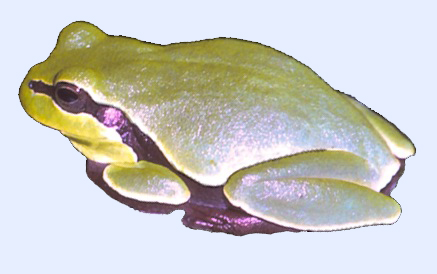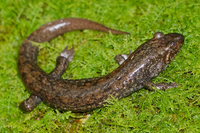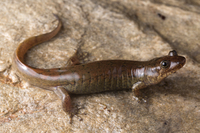Taxonomy
Class: AmphibiaOrder: CaudataFamily: PlethodontidaeSubfamily: Plethodontinae
Taxonomic Comments: Members of the genus Desmognathus are commonly known as dusky salamanders because of their overall dark brown or dusky ground color. Like many plethodontid salamanders, they have proven to be a taxonomically challenging group that contains several species complexes. Kozak et al. (2005) documented 35 major lineages in the eastern US, even though only 22 species were formally recognized by taxonomists in 2021. This suggests that there are numerous cryptic species that remain to be described. A more recent comprehensive molecular survey of populations in the eastern US by Beamer and Lamb (2020) indicate that at least 45 major lineages or clades are present. D. quadramaculatus ) as a species that can be identified by its relatively large size, stocky build, keeled and laterally compressed tail, cornified toe-tips, and black belly. If differs from the Shovel-nosed Salamander (D. marmoratus ) in several traits, the most obvious being differences in the shape of the internal nares. Recent molecular studies by Beamer and Lamb (2020), as well as several previous studies, have shown that these two species are not monophyletic. Instead, populations of both species are interspersed within a strongly supported clade that contains all populations of D. quadramaculatus , D. marmoratus , and a third species, D. folkertsi . This major clade contains two subclades, including one that includes all D. quadramaculatus populations sampled south of the Pigeon River, as well as all D. marmoratus populations sampled in the Apalachicola and Savannah River drainages. The second subclade includes all populations of D. quadramaculatus sampled from east of the Tuckasegee River drainage basin (with one exception) as well as all populations of D. marmoratus sampled outside the Apalachicola and Savannah River drainages. In some cases populations of D. quadramaculatus are more similar genetically to D. marmoratus than to other D. quadramaculatus populations. Collectively, the research by Beamer and Lamb (2020) and Pyron et al. (2020) indicates the presence of a species complex that involves all three currently recognized species. D. folkertsi , and four new species (D. amphileucus , D. gvnigeusgwotli , D. kanawha and D. mavrokoilius ) that replace what was traditionally known as D. quadramaculatus and certain populations of D. marmoratus . These are best identified in the field by the site of collection (see range map above).Species Comments: The specific epithet for this species (gvnigeusgwotli) was bestowed by the Eastern Band of Cherokee Indians from Tsalagi words that translate roughly to ‘black belly’; Gv ni ge is for black (pronounced as 'guh knee gay') and U sgwo tli is for belly (pronounced as 'oo sgwo tli').
Identification
Description: Desmognathus gvnigeusgwotli closely resembles other members of the Black-bellied Salamander complex and cannot be reliably separated using external coloration or patterning. It can be identified using molecular markers and has a set of unique mitochondrial haplotypes and fixed differences at numerous mitochondrial and nuclear loci (Pyron and Beamer, 2022). It is best identified in the field using its geographic range and the site locality (see distribution map above). This species is mostly restricted to the Great Smoky Mountains, but there are a few isolated records from the Unicoi, Great Balsam and Bald Mountains (Pyron and Beamer, 2022). Specimens from outside of the Great Smoky Mountains need to be identified using genetic markers since they may coexist with other members of the complex. Populations within the Great Smoky Mountains can usually be assigned to this species based on locality, but there is a narrow contact zone with D. mavrokoilius in the northeastern edge of the Great Smoky Mountains in extreme northern Haywood County where genetic identification may be required. Like other members of the Black-bellied Salamander complex, D. gvnigeusgwotli is a large, stocky Desmognathus with a black belly and usually two rows of light dots along each lower side of the body. The keeled tail is laterally compressed, and the toe tips are black and cornified. D. gvnigeusgwotli is generally indistinguishable from D. amphileucus , but typically exhibits some differentiation of lateral and dorsal color pattern. It also usually has some grayish or salt-and pepper mottling on the ventral surfaces versus a more frequent solid jet-black venter as seen in D. amphileucus . Very large adults are often uniformly dark above and below. Desmognathus species that are not members of the Black-bellied Salamander complex, and have whitish gills and dark toe tips. The young juveniles have a light venter that turns black with grayish or salt-and-pepper mottling within the first year after metamorphosing. Online Photos: Google iNaturalist Observation Methods: The adults are most easily collected by turning large rocks or other cover in streams. At night, they often can be observed with their heads or upper bodies protruding from burrows and cover objects. AmphibiaWeb Account
Distribution in North Carolina
Distribution Comments: Desmognathus gvnigeusgwotli is found mostly in the Great Smoky Mountains of western North Carolina and eastern Tennessee, with isolated genetic and specimen records from the Unicoi, Great Balsam, and Bald Mountains. In North Carolina it occurs in Swain County, portions of Haywood County, and northeastern Jackson County. Distribution Reference: Pyron and Beamer (2022)County Map: Clicking on a county returns the records for the species in that county.
GBIF Global Distribution
Key Habitat Requirements
Habitat: Local populations of this and other members of the Black-bellied Salamander complex are strongly associated with perennial mountain streams and stream-seepage complexes. The known habitats range from headwater tributaries and seepages to large trout streams with rapidly flowing water. Members of the complex often found in swifter current than most other Desmognathus species, and can reach high densities in small, unsilted streams with numerous rocks, cobble, and coarse woody debris (Petranka 1998). Populations are most commonly found at elevations from 490-1676 m (Hairston 1949, Organ 1961a), but may occur at lower elevations if local conditions are suitable. The adults and juveniles are typically found directly in or near flowing water, but large adults sometimes forage on the forest floor -- particularly at high-elevation sites. They are only rarely found more than 10 meters or so from a stream bank, and usually much closer when foraging on land.
Life History and Autecology
Breeding and Courtship: Very little is known about the courtship behavior and breeding season of this species, but it is presumably very similar or identical to that of D. amphileucus that was described by Verrell (2006). Members of the Black-bellied Salamander complex appear to breed during the warmer months of the year from at least May through September (Organ 1961a; Verrell 2006). The following description of the courtship of D. amphileucus from Macon County by Verrell (2006) very likely applies to D. gvnigeusgwotli . Reproductive Mode: Females of the Black-bellied Salamander complex typically attach their eggs singly to the undersides of rocks, stones or other support structures in tight clusters, and often in fast-flowing water that facilitates aeration. Nests have also occasionally been found above the water line in or near the streambed. The eggs can appear as a closely packed monolayer when attached to flat surfaces or as a bilayer when attached to concave or irregular surfaces (Petranka 1998). Each egg is suspended by a short elastic pedicel that is about 3 mm long and 1.5 mm in diameter. Two clutches from the Great Smoky Mountains (D. gvnigeusgwotli ) and Nantahala Mountains (D. amphileucus ) in North Carolina each contained several subclusters of 2-8 eggs that were attached to a common stalk (Smith et al. 1996a). D. kanawha or D. mavrokoilius in Virginia on 22 June in early to middle stages of development (Organ 1961a), 10 nests of a mixture of D. amphileucus and D. mavrokoilius in western North Carolina between 13 June and 6 August in moderate to advanced stages of development (Pope 1924), and several clutches at or near hatching in early August that were either D. amphileucus or D. mavrokoilius (Orr and Maple 1978). Austin and Camp (1992) found eggs of D. amphileucus in May and hatchlings that were 16 mm SVL in July in a Georgia population. In most instances, females were found guarding their egg masses. Nests discovered by Pope (1924) contained from 26-38 eggs and averaged 32 eggs, while those observed by Organ (1961a) varied from 21-43 and averaged 31. Collazo and Marks (1994) reported an average of 54 eggs (52-56) for five females that oviposited in the both the field and laboratory (one after hormonal injection). As seen in other Desmognathus species, clutch size of the members of this complex is positively correlated with female SVL (Tilley 1968).Aquatic Life History: Hatchlings of the Black-bellied Salamander complex have conspicuous yolk masses and live on their yolk reserves for 1-2 months after hatching (Petranka 1998). The larvae mostly feed on small invertebrates and incorporate larger prey into the diet as they grow. Davic (1991) found that most (82%) of the diet of larval D. amphileucus consisted of aquatic prey, including mayflies, stoneflies, craneflies, chironomids, nematodes, collembolans, crayfishes, and salamander larvae. Large larvae of D. amphileucus will also eat the larvae of the Blue Ridge Two-lined Salamander in experimental settings (Beachy, 1994). Small larvae are often common in perennial seepages and under cobble and small to medium-sized rocks in first and second-order streams. Davic and Orr (1987) estimated the total densities of larval, juvenile, and adult D. amphileucus in streams in western North Carolina to be 5.6-11.7 individuals/m2 of stream bed. (Bruce (1985a) found that small larvae of D. amphileucus often drift or are displaced downstream during flood events, and older larvae tend to prevail in fast-flowing sections of higher-order streams. Although poorly documented, the diet and larval ecology of D. gvnigeusgwotli is presumed to be similar to that of other members of the complex. D. kanawha or D. mavrokoilius since his study site was at the boundary between the ranges of these two species. Bruce (1985a) estimated the larval period of D. amphileucus in one western North Carolina population to be approximately 3 years, but local populations of D. amphileucus vary significantly in length of the larval period and size at metamorphosis (Bruce 1988a, 1989). Individuals usually metamorphose after 2-4 years of growth, but most appear to have a 3-year or 4-year larval period. At a low elevation site in Georgia, the larval period of D. amphileucus lasts nearly 3 years and larvae transform in May and June when they average 40-43 mm SVL (Austin and Camp 1992, Petranka 1998). Although specific information on the length of the larval period of D. gvnigeusgwotli is not available, the larval period presumably lasts 2-4 years depending on the elevation and site conditions.Terrestrial Life History: After metamorphosing the juveniles and adults tend to remain in stream beds, seepages, and other aquatic habitats. The juveniles often abound in seepages and headwater streams with moderate water flow and numerous small stones that serve as cover, while the adults are more likely to be found in streams under large rocks or logs, or in burrows in the streambanks (Petranka 1998). Kucken et al. (1994) found that about 30% of adults of D. gvnigeusgwotli that they observed at night along a stream in the Great Smoky Mountains were > 5 m from streams and several animals were > 10 m from the stream's edge. D. gvnigeusgwotli is poorly documented, but is presumed to be similar to that of other members of the Black-bellied Salamander complex. The information that follows on other members of the complex likely applies to D. gvnigeusgwotli as well. D. kanawha or D. mavrokoilius since the study was conducted in the zone of contact between these species. Bruce (1988a, 1989) estimated the minimum age at first reproduction of D. amphileucus in western North Carolina populations to be 6 years for males and 7 years for females. Age-specific survivorship is relatively constant for metamorphosed males, but increases after females reach sexual maturity (Organ 1961a). D. amphileucus feed primarily on aerial prey. Only 36% of prey were aquatic organisms, while the adults fed mostly on terrestrial species. Terrestrial organisms eaten by juveniles and adults include hymenopterans, lepidopterans, beetles, centipedes, and spiders. Hairston (1949) found a variety of aquatic and terrestrial insects in specimens from North Carolina including stoneflies, flies, ants, collembolans, and bugs. These appeared to specimens of D. mavrokoilius . Black-bellied salamanders in northern Georgia consumed stoneflies, mayflies, caddisflies, true flies, beetles, hymenopterans, and other salamanders (Martof and Scott 1957). Eurycea , Desmognathus , and Plethodon that inhabit stream and streamside communities (Camp 1997). Bishop (1924) found four salamanders (including a Plethodon ) in five specimens that he examined, while Formanowicz and Brodie (1993) found that relatively small D. ocoee were most vulnerability to attack or injury by D. amphileucus . Owen McConnell photographed an adult D. amphileucus feeding on a Plethodon teyahalee in Graham County.
General Ecology
Adverse Environmental Impacts
Status in North Carolina
NHP State Rank: [S4]Global Rank: GNRStatus Comments: Desmognathus gvnigeusgwotli is found mostly in the Great Smoky Mountains of western North Carolina and eastern Tennessee, with a few isolated specimen records from the Unicoi, Great Balsam and Bald Mountains. In North Carolina it occurs in Swain County, portions of Haywood County, and northeastern Jackson County. Populations can reach high densities in high-quality, lower-order streams and seepages at mid- to higher elevations. Most populations are in national parks or national forests and have a relatively high degree of protection from timbering or developent that could impair streams. The greatest future threats are likely those associated with climate change and the excessive deposition of atmospheric pollutants.

 »
»



 »
»

